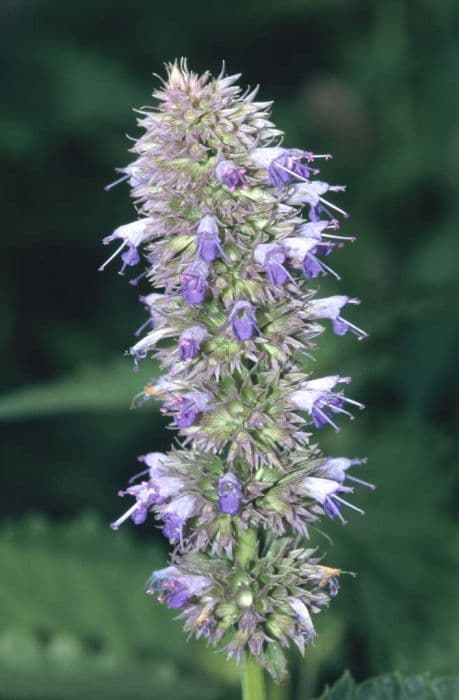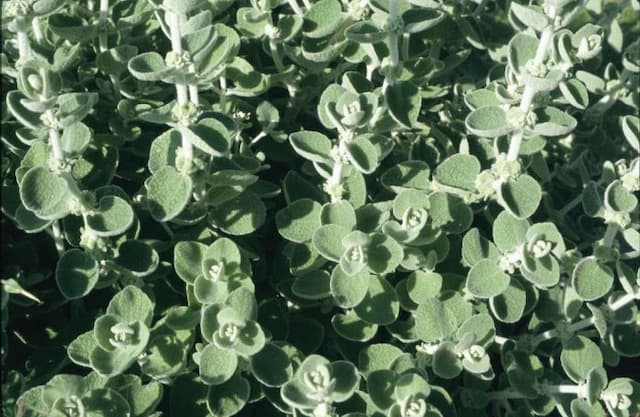Bee Balm Monarda didyma Balmy Rose = 'Balbalmose' (PBR) (Balmy Series)

ABOUT
The plant known as Balmy Rose, which is part of the Balmy Series, features a striking appearance commonly admired in garden settings. It is cherished for its lush green foliage and the distinctive, vibrant rosy-pink flower heads that it produces. These flowers are tubular in form and are arranged in dense, rounded clusters atop the plant's stems, giving it a decorative pompom-like effect that is very eye-catching. The blooms are known for their sweet, aromatic fragrance, which is especially attractive to pollinators such as butterflies and hummingbirds, adding an additional layer of charm and activity to the garden. The Balmy Rose has a bushy, clump-forming habit, with the foliage comprising lance-shaped, medium green leaves that have a slightly serrated edge. The overall appearance of the plant is one that exudes both color and vibrance, making it a popular choice among gardeners seeking to add a touch of romance and allure to their outdoor spaces.
About this plant
 Names
NamesFamily
Lamiaceae.
Synonyms
Bee Balm, Oswego Tea, Scarlet Beebalm, Crimson Beebalm, Red Bergamot.
Common names
Monarda didyma Balmy Rose = 'Balbalmose' (PBR) (Balmy Series)
 Toxicity
ToxicityTo humans
Bee Balm is generally not considered toxic to humans. It is often used in herbal remedies and as an edible flower in culinary applications. There is no well-documented evidence of toxicity from consuming Bee Balm. However, as with any plant, individual allergies or sensitivities could result in mild reactions, but these are not common.
To pets
Bee Balm is also generally considered non-toxic to pets. It is not listed on toxic plant lists by organizations such as the ASPCA. Pets ingesting Bee Balm are unlikely to experience more than mild stomach upset, if anything at all. It is always a good precaution to supervise pets around plants and to discourage them from eating ornamental plants, regardless of their known toxicity profile.
 Characteristics
CharacteristicsLife cycle
Perennials
Foliage type
Deciduous
Color of leaves
Green
Flower color
Pink
Height
1-2 feet (30-60 cm)
Spread
1-2 feet (30-60 cm)
Plant type
Herb
Hardiness zones
4
Native area
North America
Benefits
 General Benefits
General Benefits- Attracts Pollinators: The flowers are highly attractive to bees, butterflies, and hummingbirds, which can help pollinate other plants in the garden.
- Aromatic Foliage: The leaves of the Monarda didyma emit a pleasant fragrance, adding a sensory dimension to the garden.
- Showy Flowers: The Balmy Rose variety boasts vibrant, rose-pink flowers that add a splash of color to garden beds and borders.
- Compact Growth Habit: Being part of the Balmy Series, 'Balbalmose' has a more compact growth, making it suitable for smaller spaces and containers.
- Disease Resistance: This cultivar has been bred for improved resistance to powdery mildew, a common problem in Monarda species.
- Long Blooming Period: The plant has a lengthy flowering season, providing color from early to late summer.
- Easy to Grow: Monarda didyma is known for being low-maintenance and easy to cultivate in a variety of conditions.
- Culinary Use: The leaves can be used to make tea or to flavor foods, although this is not a primary benefit, it can be an added plus for some gardeners.
- Erosion Control: The plant's root system can help stabilize soil and prevent erosion.
- Landscape Versatility: It can be used in a variety of garden styles, including cottage, wildlife, and perennial borders.
 Medical Properties
Medical Properties- Antiseptic: Monarda didyma contains thymol, which has antiseptic properties that may help in preventing infections.
- Carminative: The plant is traditionally used to help relieve digestive issues such as gas and bloating.
- Antifungal: The essential oils derived from Monarda didyma have been known to exhibit antifungal effects.
- Antioxidant: The plant contains compounds with antioxidant properties, which can help in neutralizing free radicals.
- Anti-inflammatory: It may possess anti-inflammatory properties, offering potential relief for inflammation-related conditions.
 Air-purifying Qualities
Air-purifying QualitiesThis plant is not specifically known for air purifying qualities.
 Other Uses
Other Uses- Fabric Dyeing: Bee Balm leaves and flowers can be used to produce a natural dye for coloring fabrics with shades of pink, brown, or olive green, depending on the mordant used.
- Photographic Subject: The vibrant flowers of Bee Balm make it an excellent subject for botanical photography, attracting photographers interested in capturing its unique structure and color.
- Garden Border: Bee Balm can be planted along the edges of garden beds to create an attractive, colorful border that also helps deter pests with its strong scent.
- Companion Planting: When planted alongside vegetables like tomatoes, Bee Balm can help to attract pollinators and improve the growth and yield of the vegetable plants.
- Ice Cream Flavoring: The leaves of Bee Balm can be infused into cream to create an unusual and aromatic ice cream flavor, reminiscent of earl grey tea with a hint of mint.
- Culinary Garnish: Fresh Bee Balm flowers make a striking edible garnish for salads, desserts, and cocktails, adding both color and a hint of citrus to dishes.
- Floral Arrangements: Bee Balm's long, sturdy stems and showy flowers make it an excellent choice for cut flower arrangements in bouquets and centerpieces.
- Wildlife Habitat: Planting Bee Balm in your garden can provide a habitat and food source for beneficial insects such as bees, butterflies, and hummingbirds.
- Tea Flavoring: Dried Bee Balm flowers can be added to teas for flavoring, imparting a taste reminiscent of bergamot and a floral aroma.
- Artistic Inspiration: The distinct look of Bee Balm has inspired artists and craftspeople to incorporate its form and colors into various works, from botanical illustrations to fabric patterns.
Interesting Facts
 Feng Shui
Feng ShuiBee Balm is not used in Feng Shui practice.
 Zodiac Sign Compitability
Zodiac Sign CompitabilityBee Balm is not used in astrology practice.
 Plant Symbolism
Plant Symbolism- Attractiveness: Monarda didyma, commonly known as Bergamot or Bee Balm, is renowned for its ability to attract bees, butterflies, and hummingbirds, symbolizing allure and magnetic charm.
- Healing: Historically used by Native Americans for its medicinal properties, Bergamot symbolizes healing and the relief of ailments.
- Balance: The balance of its sweet, intense fragrance and its vibrant flowers symbolizes equilibrium and harmony in life.
- Happiness: With its bright, cheerful flowers, Bergamot represents joy and the spread of happiness.
- Peace: The soothing qualities of Bergamot's essential oils make it a symbol of peace and calm.
 Water
WaterBee Balm 'Balmy Rose' should be watered deeply whenever the top inch of soil feels dry to the touch, which typically means watering once or twice a week, depending on weather conditions. Supply the plant with about one to two gallons of water per session to ensure the soil is moistened thoroughly. Overhead watering should be avoided to prevent powdery mildew; instead, water at the base of the plant. During periods of drought or extreme heat, additional watering may be necessary to maintain consistent soil moisture. It's important not to overwater, as Bee Balm does not like to sit in waterlogged soil.
 Light
LightBee Balm 'Balmy Rose' thrives in full sun to partial shade. It prefers to receive at least six hours of direct sunlight daily, so placing it in a spot where it can enjoy the morning sun and receive partial shade in the afternoon is ideal. Avoid deep shade locations, as inadequate light can affect its blooming and make it more susceptible to diseases.
 Temperature
TemperatureBee Balm 'Balmy Rose' can withstand a range of temperatures but grows best in conditions between 60°F and 70°F. It is hardy in zones 4 to 9, meaning it can survive minimum winter temperatures of -30°F and tolerate summer highs usually not exceeding 90°F. The plant benefits from cooler nighttime temperatures, which help to ensure vigorous growth and blooming.
 Pruning
PruningBee Balm 'Balmy Rose' requires pruning to promote bushier growth and to encourage more blooms. Deadheading, or the removal of spent flowers, should be done consistently throughout the blooming season. Cutting back the entire plant by one-third after the first bloom can result in a second flush of flowers later in the season. The best time to prune for shaping is in early spring, just as new growth begins.
 Cleaning
CleaningAs needed
 Soil
SoilBee Balm 'Balbalmose' thrives best in a soil mix with good drainage, composed of loamy soil enriched with organic matter. Aim for a soil pH ranging from neutral to slightly acidic, around 6.0 to 7.0.
 Repotting
RepottingBee Balm 'Balbalmose' does not typically require frequent repotting and is usually repotted only when it outgrows its current container or when the soil needs to be refreshed, typically every 2-3 years.
 Humidity & Misting
Humidity & MistingBee Balm 'Balbalmose' prefers moderate to high humidity levels but is adaptable to a wide range of humidity conditions in outdoor settings.
 Suitable locations
Suitable locationsIndoor
Grow Bee Balm 'Balbalmose' indoors with bright indirect light and good airflow.
Outdoor
Plant Bee Balm 'Balbalmose' in full sun to partial shade with moist soil.
Hardiness zone
4-9 USDA
 Life cycle
Life cycleMonarda didyma Balmy Rose, commonly known as Bee Balm or Bergamot, starts its life cycle when the seeds germinate in spring, typically requiring a period of stratification to break dormancy. Seedlings emerge and develop into young plants with a rosette of leaves close to the ground. As spring progresses into summer, the plants grow upright stems and foliage, and by early to mid-summer, they produce their distinctive rose-pink tubular flowers arranged in whorls at the stem's top, attracting pollinators such as bees and hummingbirds. After pollination, the flowers develop into nutlet-like fruits that contain the seeds for the next generation. By late summer or fall, the plant becomes dormant, with the aerial parts dying back and the plant relying on its underground rhizomes to survive the winter. The following spring, new growth emerges from the rhizomes, continuing the cycle.
 Propogation
PropogationPropogation time
Spring-Early Summer
The most popular method of propagation for the Bee Balm 'Balmy Rose' is by division. This process is best undertaken in the early spring or autumn when the plant is not in active bloom. To propagate by division, you carefully dig up the parent plant and gently separate it into smaller sections, ensuring each section has a portion of the root system attached. These divisions can then be replanted at the same depth they were previously growing, spaced about 18 to 24 inches apart (45 to 60 cm). Water the new divisions thoroughly after planting to help establish them. This form of asexual reproduction maintains the genetic consistency of the 'Balmy Rose' variety.









